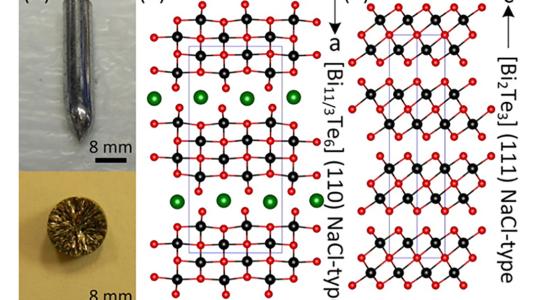
Understanding how non-conventional systems with low carrier density can result in superconductivity is a new challenge and of fundamental importance. In this part the underlying science-driver is studying the emergence of superconductivity in semiconductors with compositional doping. In this case superconductivity is manifested in systems with intrinsic low carrier density (e.g. 1019 cm-3) in contrast to the vast majority of superconductors which have very high carrier densities (1022 cm-3). Because low carrier density generally leads to a very small density of states at the Fermi energy, historically it has not been thought to be conducive to superconductivity. Therefore such superconducting systems are both interesting and rare.
RbBi11/3Te6 is a narrow gap semiconductor featuring Bi vacancies and band gap of 0.25 eV at room temperature and exhibits a sharp superconductivity at 3.2 K. A needle-like crystal of RbBi11/3Te6 adopts a layered structure composed of [BiTe6] octahedral forming defected infinite [Bi4Te6] layers which contain one third of Bi3+ vacancies balanced by Rb+ ions sandwiched between the layers, Fig. 1. The structural flexibility of the [Bi2Q3] block to form layers of different orientation and width is a powerful feature in the design of compounds where their composition and structure can be predicted using the concept of homologous relationships. A series of isovalent substitutions of the Te2- site with Se2- atoms and the Bi3+ site with Sb3+ atoms was investigated. Tc changes for every substitution made in the series RbBi11/3SexTe6-x (0 < x < 2.1), RbBi11/3-ySbyTe6 (y = 0.3, 0.6), and RbBi11/3-ySbySexTe6-x (x,y = 0.3), Fig. 2(A). Interestingly, Tc increases to 3.4 K upon substitution with Se in the RbBi11/3SexTe6-x series until an optimum concentration is reached (x = 0.55(5)) after which Tc degreases gradually and finally disappears above x ≈ 2.1 where the solubility limit of Se in RbBi11/3Te6 is reached. There is a superconducting dome of Tc as a function of composition of the RbBi11/3SexTe6-x series is shown in Fig. 2(B) which peaks at x = 0.55(5). The discovery of superconductivity in the RbBi11/3Te6 system forecasts the potential existence of other interesting superconductors in the class Rb[Bi2n+11/3Te3n+6] which is a homology that can be more generally represented as AM3+mTe5+m, where A is an alkali metal and M can be a combination of divalent and trivalent metals, e.g., the CsPbmBi3Te5+m series.
“Superconductivity in the narrow gap semiconductor RbBi11/3Te6” Malliakas C. D., Chung D. Y., Claus H., Kanatzidis M. G. J. Am. Chem. Soc. 2016,138, 14694-14698. (DOI: 10.1021/jacs.6b08732)
